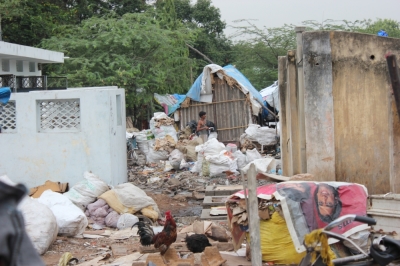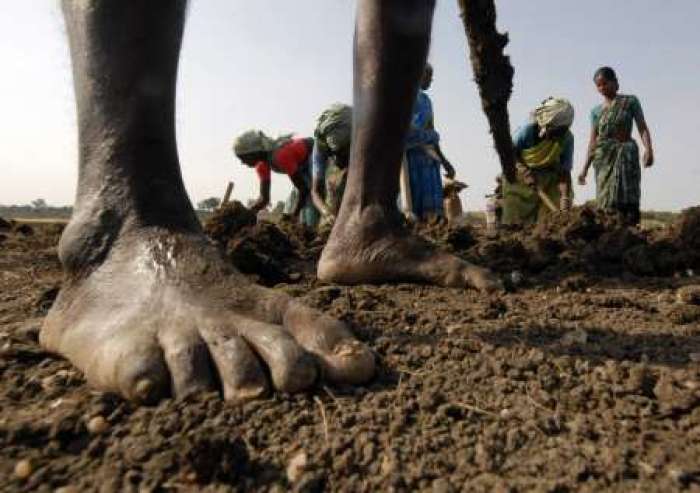The Forgotten People of India: Child Laborers Part II
The Christian Post had the opportunity to travel to India to observe the work Christians are doing throughout the country to help empower a societal group that has been neglected for the better part of recorded human history. This is the second part of a four part series detailing their work.
"Jesus said, 'Let the little children come to me, and do not hinder them, for the kingdom of heaven belongs to such as these.'" Matthew 19:14.
Children of poverty stricken families in India have been increasingly subjected to exploitation in the name of industrial prowess and business efficiency by employers placing them on the path of bonded child labor. Children from poor families are at the greatest risk of becoming child laborers due to their lack of education and their family's desperate situation.
Child labor has had a tumultuous history in India that has been fueled largely by perpetual and rampant poverty coupled with lax enforcement of laws that do little to quell the rising tide of child-slave workers.

K. Rajendran is the Overseas Coordinator for Operation Mobilization and works out of the Doddagubbi Post in Bangalore, Karnataka. Growing up he worked in a factory making fireworks and he still vividly remembers the colors, chemicals and cruelty that today's children of India endure every day.
The International Labor Organization (ILO) estimates that around the globe more than 300 million children between the ages of 5 and 14 works to earn wages. Over 50 million children work as bonded laborers.
Raj, as he is known by his friends, came from a Dalit family with several siblings who all worked to support the family. When Raj was a young boy of five or six, he would walk several kilometers from his village in northern India to a factory, where he would work from morning until well after dark putting together fireworks.
The work Raj described was treacherous. Most of the workers were children with no safety protections and were exposed to dyes and other chemicals that left their hands the colors of your favorite fireworks. Children that worked in the factory were abused and treated as disposable labor, with consequences for the offenders falling by the wayside of complicit regulators.
Raj told stories of kids fainting from the fumes in the factory, children being maimed from factory equipment and youth constantly being abused and harassed by superiors- all of these atrocities were considered the price of doing business.
Raj described one such occurrence involving a supervisor of the factory and a young boy. The supervisor noticed the unconscious child on the floor of the factory while others were assembling fireworks. Raj somberly revealed that he simply took the child from off the floor and put him outside behind the factory.
The recount was just one of a common occurrence, but it sheds light on one of the greatest risks to children of poor Dalit families across India.
Research suggests the average age of child workers is decreasing, making action ever more vital, given that most children come from impoverished families. Subjecting a child to such exploitation is not the reality for children of affluence or upper castes.
Organzations workin to help end child labor continually highlight India as one of the worst perpetrators of bonded child labor, with the greatest challenge being keeping children with their families.

While kidnappings and abductions are a serious threat for the Dalit children of India, the greatest challenge facing advocates to end child labor is from families, who sell their children to traffickers or to "agents" working directly with the factory under the guise their children will work and earn a decent wage.
While the payment, ranging from $50 to a few hundred dollars, may seem like an extremely small amount, to the poorest families it is almost the equivalent of an entire year's wages, given that a majority of Dalits live on roughly one dollar a day.
Child workers and bonded child laborers are not isolated to one nation or region and the practice is seen as a growing business opportunity, given the cheap labor and limited overhead cost, compounding the global problem.
One can point to the recent factory fire in Bangladesh where over 100 people died. While there are no reports of any children dying in that fire, there were reports of egregious impropriety, exposing for a fleeting glimpse some of the business practices in the region and throughout the world.
During a recent convening of the United Nations, a report was published and showed the problem is displaying no signs of slowing down. In fact, the problem seems to be getting worse as an estimated 27 million children are enslaved worldwide, comprising part of the estimated $100 billion a year trafficking business.
India has the dubious distinction of being the country with the largest number of child laborers in the world. Child laborers in India endure miserable and difficult childhoods and earn virtually nothing as they struggle to make enough to feed themselves, let alone their families. What is holding children in this vicious cycle is the simple fact that children from Dalit families do not have an opportunity to gain an education or even basic life skills, which makes it even easier for them to be subjected to exploitation.
Experts in India cite child labor is the result of unsustainable systems of landholding in agricultural areas, the wide observance of the caste system in rural areas and labor demand in urban settings. In rural India there are not extensive record keeping operations, with landholdings usually having more than one person or family with claims to the land.
Children are easily exploited without worker documentation when coupled with the fact that most transactions are completed orally.
Another causing factor is that children who are forced to work to pay off debts that their families have made. However, those agreements are almost always made verbally, given that a large percentage of Dalits are illiterate, leading to child workers never officially working off their debts.
This unique situation is created between Dalit parents and what is referred to as an agent. The nature of the agent is simple; he serves as the contact between the parents and the employers, who would benefit from the cheap labor.
Raj explains that these types of arraignments, where parents are contacted by these agents, are usually informal with no written record of the transaction. The term of bonded labor is usually never fixed, which makes tracking and completing a time of servitude nearly impossible.
India's Dalit children face the most severe hardships because there are few protections provided by Indian law for children forced to work in factories. Some reports from India have stated that children as young as four have been forced to work in factories and in fields across India.
Child labor is first and foremost a source of income for poor families, with studies claiming that child labor contributes nearly a third of an impoverished family's income. That is significant considering the average Dalit lives on around one dollar per day.
To quell rising voices, the Indian government has put provisions in place over recent years to address the growing number of child laborers, but enforcement is waning as the majority of children sold to work in factories come from Dalit families.
One of the few laws that are on the books is the Child Labor Prohibition and Regulation Act. This law allows children under the age of 14 to work in jobs classified as non-hazardous, but prohibits children under the age of 14 to work in any job that is classified as hazardous. The law also limits the number of hours any child worker is allowed to work in a single day.
Many advocates hoping to end the exploitation of children view this law in two lights. First, the law does address the growing problem, but porous oversight negates any of the laws effectiveness, especially in rural areas.
The second perspective addresses the fact that the law does not help keep kids out of factories and in school where they belong, but rather affords an opportunity to deprive a child of an education in the name of production.
The indifference towards Dalit's adds to the perpetual cycle of poverty that is fostered within the caste system, the predominant social structure that has constrained generations of Dalits and has left a significant portion of the Indian population unable to advance up the socio-economic ladder.
To provide a voice to the Dalits, the Dalit Freedom Network (DFN) and Operation Mobilization have solidified their commitment to ending the longstanding torment of the Dalits by enabling them with the knowledge and resources needed in order to provide a path away from the confines of poverty and into a position filled with dignity and full of self-worth.
The Dalit Education Centers, which are built with the help of generous donations facilitated by Lead Pastor Matthew Cork and Friends Church, are able to provide vocational training such as sewing or tilling land that will provide Dalit children a means to earn self-sustaining income.
The DFN has made the prevention of child labor a top priority and is using education and the message of Jesus Christ as a way to lift up the ones trapped under the social weight of the caste system.





























